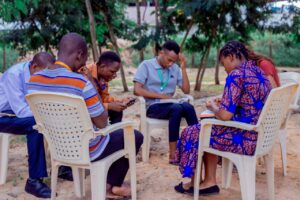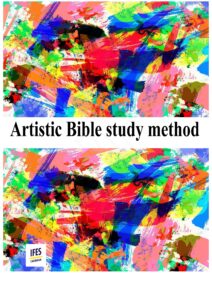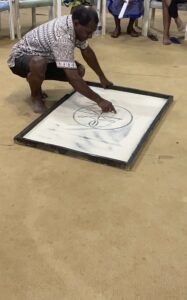Vanuatu is a cluster of islands in the South Pacific and home to the Gud Nius Yunivesiti Felosip (GNYF), our IFES movement. Most of our country is still populated by small, subsistence-farming communities, and only a tiny portion will ever be involved in tertiary education (<1%). Many students will come to university having grown up in churches their whole lives, but still unsure of how to listen carefully to God’s Word and sometimes unclear on exactly who Jesus is or why our love, trust, and knowledge of him is vital. Even at the tertiary level, our students don’t really enjoy sustained engagement with written texts, preferring to hear and talk about what matters.
We wanted to devote a year to intentionally sharing the gospel with our friends and classmates on campus in ways that fit the relational nature of the islands and the strong oral preference in learning, as well as helping people engage with Jesus by piercing through the ‘church background noise’. We decided on a Melanesian version of ‘Uncover’ (a well-received gospel distribution project) called ?Huia Jisas?—Who is Jesus? While this focused mainly on students sharing stories from Mark with other students, we also planned some key public events that would connect our networks with the wider university community in a ‘Vanuatu’ way.
One of the traditional ways of imparting knowledge in Vanuatu is sandroing (or bwatiuli in the Raga language from Pentecost Island). This involves making patterns in the ground with a finger to leave messages, share information, or pass on significant stories. Our idea was to use this local artform to convey the gospel stories we wanted our friends and classmates to hear. We connected with a local bwatiuli expert, Uncle Edgar, to develop four new patterns that reflected four themes from those gospel narratives: sin, forgiveness, reconciliation, and rule.
After a few weeks of reading and discussing the Mark narratives with Uncle Edgar, we presented these new patterns during a special event at our regional university campus. Our staff worker and students told four key stories from Mark, then Uncle Edgar introduced us to a traditional-style story and song he’d composed. It described two people (representing us and God) in a relationship that had broken but been reconciled. As he played the bamboo flute and shared each part of the story, he carefully drew the complex arcs and shapes representing the characters and concepts of what was being told.
As far as we (or Uncle Edgar) know, this is the first time that sandroing has been used in collaboration with and to share the Scriptures. He is excited to take these stories and patterns to his church so that Vanuatu can hear—and see—the good news of Jesus, settled in their hearts and etched in their land.
Tag Archives: Bible study
The Beauty of Discovery Bible Study
In TAFES (Tanzanian National Movement), Discovery Bible Study (DBS) is one of the approaches we use, and it has captured the hearts of many students and associates!
We utilise DBS for small group study by following this simple process:
- one member reads the passage and
- the group retells the story (passage), then
- we answer a few main questions together; these are:
- What have I discovered about God?
- What have I discovered about people?
- How do I obey God through this Word?
- Who I am going to tell?
How did it start?
 It was during a staff retreat in February 2021 that our Campus Ministry Coordinator, Sister Joan Wanjiru, proposed trying the DBS method to see if it would be suitable for training students. We used DBS for the first time at that retreat and later in Discipleship
It was during a staff retreat in February 2021 that our Campus Ministry Coordinator, Sister Joan Wanjiru, proposed trying the DBS method to see if it would be suitable for training students. We used DBS for the first time at that retreat and later in Discipleship
Training Seminars (DTS) throughout the country. After the success in 2021, we repeated this study technique during DTS in 2023. Although Inductive Bible Study and Manuscript Bible Study are still in use, DBS has become the most loved and practised approach by many Christian Unions since its introduction.
Uniqueness of DBS:
There’s something special about Discovery Bible Study and its popularity is fostered by these unique advantages:
- Easy to teach and practice. Understanding how to use DBS requires simple training. The discovery questions (above) are easy to remember, making it accessible, even if it’s a person’s first time.
- Importance of application. The practice of DBS is not complete until a person specifically addresses the question of how they will obey the Word that is being studied.
- Tool for evangelism and discipleship. Through DBS, there’s always an increase in the number of people coming to Christ and the growth of members’ spirituality. Using this method of study with a non-believer may draw them to Christ and provides an opportunity for members to tell others about the Word of God.
- Connects people in the group. Since DBS preserves the principle of small groups, participants get to relate to each other beyond just discussing DBS questions.
Jusline C. Nkala, treasurer TAFES KIUT CU:
“It was amazing during DTS 2023 when we used this method to study the book of 1 Samuel. DBS is one of my good and best methods that I have encountered in terms of Bible study because we stay in a group and read the Bible story together, we discover what Scripture says about God and people, and we challenge ourselves to live according to the Word and share the Word with our friends”.
Tumaini Titus
Regional coordinator – TAFES Tanzania
From Caribbean region: The Artistic Bible Study Method
 I am happy to share with you an approach we use in the CARIFES region called “The Artistic Bible study method”. It was developed to guide students into the Scriptures from an artistic point of view.
I am happy to share with you an approach we use in the CARIFES region called “The Artistic Bible study method”. It was developed to guide students into the Scriptures from an artistic point of view.
This way of reading can help participants appreciate the details of a passage, while learning to communicate that appreciation in a creative and easy way. What remains of central importance is that we are engaging in the process of exploration. As an additional benefit, students may discover a new talent and enjoy the experience.
However, allow me a few words of caution before explaining this method further. While it is good, this approach may not be adequate in all cases, and it is the leader’s responsibility to manage the choice of texts accordingly. The goal is for participants to respond to the Bible passage using multiple senses and from different perspectives, increasing the possibilities for more comprehensive appreciation of the material. As it is not a rigid method, variations can be tested and implemented.
Regarding the tools needed, every participant should have paper, pencils, and pens in different colours. If tablets are available, these could also be used.
In the first stage, participants must explore and focus on the chosen text for 5 minutes. This time allows each person to consider their understanding of the passage and how they might express that understanding in their drawing. After this, participants should be given enough time to recreate their ideas on paper and share them with the group.
Some questions that can prompt reflection and creative response include:
– Are there any keywords that catch my attention?
– What is clear or not clear?
– What relevant information or important events do I see in the passage?
– What does this mean and how is this speaking to me?
When everybody has shared and explained their drawings, there is an opportunity for what we call “Debate”. Every participant will share one thought about each drawing, considering questions such as:
– Which drawing speaks to you? Why?
– What is your favourite? Why?
– What would you do differently?
Finally, we have what is called “Go Further”. In this stage, participants have the chance to draw something new about the passage and explain what about it is different and why. As an alternative to the ‘’Debate’’, after finishing their first drawings, the group can study the text using the traditional method of ‘’Observation, Interpretation, and Application’’, after which they should complete a second drawing for discussion.
We have tested this method during a training session with students in the region and, according to the survey taken at the end of this training, it was their favourite part. I was impressed with how clearly their drawings expressed the students’ understanding of the text, but also how diverse and rich lessons from the same text can be.
Jean-Davy Frair
CARIFES regional staff team as a Francophone Staff
Sharing the Word in the context of student ministry
 The Bible has a central position in student ministry. We organise our devotional life, our training activities, our dialogue with the university and our evangelistic activities around the Holy Scriptures. The high value we place on Scripture is the base for three steps that I consider whenever I share the Word at our meetings.
The Bible has a central position in student ministry. We organise our devotional life, our training activities, our dialogue with the university and our evangelistic activities around the Holy Scriptures. The high value we place on Scripture is the base for three steps that I consider whenever I share the Word at our meetings.
Step 1: Seriously study the biblical passage and strive to apply it in a fresh and appropriate way.
We frequently receive instructions to develop a profitable reading of the Scriptures. We learn a variety of biblical study methods and use many auxiliary resources, which allow us to make a good approach to the text. Indeed, from the initial steps found in devotions, to the ability of some of us to work on the original languages, we face the challenge of using every resource available to do a good and appropriate reading of the text. Meanwhile, we need to find pathways that allow our audience to apply the lessons learned in a faithful, opportune and fresh way. Because “all Scripture is God-breathed and is useful for teaching, rebuking, correcting and training in righteousness, so that the servant of God may be thoroughly equipped for every good work.” (2 Timothy 3.16-17).
Step 2: prayer support
The nature of biblical exposition implies permanent prayer support, because it requires putting the heart of all those involved in the process (those who minister and those who listen) before the Word of the Eternal God. I once heard from a teacher; “the purpose of biblical exposition is to comfort the broken-hearted and challenge those who have become accommodated”. Nobody is indifferent before the Word, neither the person who exposes nor he who listens. As the Paul the Apostle said, “Pray also for me, that whenever I speak, words may be given me so that I will fearlessly make known the mystery of the gospel, for which I am an ambassador in chains. Pray that I may declare it fearlessly, as I should.” (Ephesians 6:19-20)
Step 3: becoming accessible to listen to those who listen
When developing biblical expositions, one of the most important moments in learning is when I decide to make myself accessible to listen to those who listened to me. This allows me to see how they have understood the text and how they are applying it to their lives; I listen to their questions, suggestions and doubts, and this has deeply enriched my continuous learning process in the ministry of biblical exposition. We should seek these moments to learn to listen in an attentive, humble, reverent and respectful way towards our brothers and sisters who received “the message in the midst of severe suffering with the joy given by the Holy Spirit… became a model to all the believers.” (1 Thessalonians 1:6-7)
These are the three simple steps I try to follow in the ministry of sharing of the Word of God.
Ziel Machado, Former IFES Regional Secretary in Latin America.



